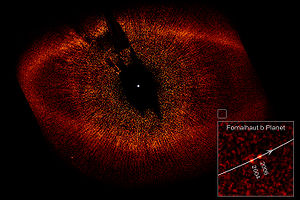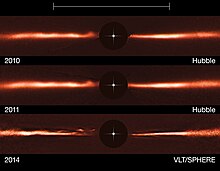Debris disk

A debris disk (
As of 2001, more than 900 candidate stars had been found to possess a debris disk. They are usually discovered by examining the star system in infrared light and looking for an excess of radiation beyond that emitted by the star. This excess is inferred to be radiation from the star that has been absorbed by the dust in the disk, then re-radiated away as infrared energy.[3]
Debris disks are often described as massive analogs to the debris in the
Observation history

In 1984 a debris disk was detected around the star Vega using the IRAS satellite. Initially this was believed to be a protoplanetary disk, but it is now known to be a debris disk due to the lack of gas in the disk and the age of the star. The first four debris disks discovered with IRAS are known as the "fabulous four": Vega, Beta Pictoris, Fomalhaut, and Epsilon Eridani. Subsequently, direct images of the Beta Pictoris disk showed irregularities in the dust, which were attributed to gravitational perturbations by an unseen exoplanet.[5] That explanation was confirmed with the 2008 discovery of the exoplanet Beta Pictoris b.[6]
Other exoplanet-hosting stars, including the first discovered by direct imaging (HR 8799), are known to also host debris disks. The nearby star 55 Cancri, a system that is also known to contain five planets, also was reported to have a debris disk,[7] but that detection could not be confirmed.[8] Structures in the debris disk around Epsilon Eridani suggest perturbations by a planetary body in orbit around that star, which may be used to constrain the mass and orbit of the planet.[9]
On 24 April 2014, NASA reported detecting debris disks in archival images of several young stars, HD 141943 and HD 191089, first viewed between 1999 and 2006 with the Hubble Space Telescope, by using newly improved imaging processes.[10]
In 2021, observations of a star, VVV-WIT-08, that became obscured for a period of 200 days may have been the result of a debris disk passing between the star and observers on Earth.[11] Two other stars, Epsilon Aurigae and TYC 2505-672-1, are reported to be eclipsed regularly and it has been determined that the phenomenon is the result of disks orbiting them in varied periods, suggesting that VVV-WIT-08 may be similar and have a much longer orbital period that just has been experienced by observers on Earth. VVV-WIT-08 is ten times the size of the Sun in the constellation of Sagittarius.
Origin
During the formation of a Sun-like star, the object passes through the T-Tauri phase during which it is surrounded by a gas-rich, disk-shaped nebula. Out of this material are formed planetesimals, which can continue accreting other planetesimals and disk material to form planets. The nebula continues to orbit the pre-main-sequence star for a period of 1–20 million years until it is cleared out by radiation pressure and other processes. Second generation dust may then be generated about the star by collisions between the planetesimals, which forms a disk out of the resulting debris. At some point during their lifetime, at least 45% of these stars are surrounded by a debris disk, which then can be detected by the thermal emission of the dust using an infrared telescope. Repeated collisions may cause a disk to persist for much of the lifetime of a star.[12]
Typical debris disks contain small grains 1–100
For collisions to occur in a debris disk, the bodies must be gravitationally perturbed sufficiently to create relatively large collisional velocities. A planetary system around the star can cause such perturbations, as can a binary star companion or the close approach of another star.[13] The presence of a debris disk may indicate a high likelihood of exoplanets orbiting the star.[14] Furthermore, many debris disks also show structures within the dust (for example, clumps and warps or asymmetries) that point to the presence of one or more exoplanets within the disk.[6] The presence or absence of asymmetries in our own trans-Neptunian belt remains controversial although they might exist.[15]
Known belts
Belts of dust or debris have been detected around many stars, including the Sun, including the following:
| Star | Spectral
class[16] |
Distance ( ly )
|
Orbit ( AU )
|
Notes |
|---|---|---|---|---|
| Epsilon Eridani | K2V | 10.5 | 35–75 | [9] |
| Tau Ceti | G8V | 11.9 | 35–50 | [17] |
| Vega | A0V | 25 | 86–200 | [18][19] |
| Fomalhaut | A3V | 25 | 133–158 | [18] |
| AU Microscopii | M1Ve | 33 | 50–150 | [20] |
| HD 181327 | F5.5V | 51.8 | 89-110 | [21] |
| HD 69830 | K0V | 41 | <1 | [22] |
| HD 207129 | G0V | 52 | 148–178 | [23] |
| HD 139664 | F5IV–V | 57 | 60–109 | [24] |
| Eta Corvi | F2V | 59 | 100–150 | [25] |
| HD 53143 | K1V | 60 | ? | [24] |
| Beta Pictoris | A6V | 63 | 25–550 | [19] |
| Zeta Leporis | A2Vann | 70 | 2–8 | [26] |
| HD 92945 | K1V | 72 | 45–175 | [27] |
| HD 107146 | G2V | 88 | 130 | [28] |
| Gamma Ophiuchi | A0V | 95 | 520 | [29] |
| HR 8799 | A5V | 129 | 75 | [30] |
| 51 Ophiuchi | B9 | 131 | 0.5–1200 | [31] |
| HD 12039 | G3–5V | 137 | 5 | [32] |
| HD 98800 | K5e (?) | 150 | 1 | [33] |
| HD 15115 | F2V | 150 | 315–550 | [34] |
| HR 4796 A | A0V | 220 | 200 | [35][36] |
| HD 141569 | B9.5e | 320 | 400 | [36] |
| HD 113766 A | F4V | 430 | 0.35–5.8 | [37] |
| HD 141943 | [10] | |||
| HD 191089 | [10] |
The orbital distance of the belt is an estimated mean distance or range, based either on direct measurement from imaging or derived from the temperature of the belt. The Earth has an average distance from the Sun of 1 AU.
See also
- Accretion disk
- Asteroid belt
- Circumplanetary disk – Accumulation of matter around a planet
- Exoasteroid belt
- Protoplanetary disk
References
- S2CID 4372235.
- ^ "Spitzer Sees Dusty Aftermath of Pluto-Sized Collision". NASA. 2005-01-10. Archived from the original on 2006-09-08. Retrieved 2007-01-03.
- ^ "Debris Disk Database". Royal Observatory Edinburgh. Archived from the original on 2008-08-10. Retrieved 2007-01-03.
- ^ "Mysterious Ripples Found Racing Through Planet-forming Disc". Retrieved 8 October 2015.
- doi:10.1086/309188.
- ^ S2CID 118046185.
- ^ "University Of Arizona Scientists Are First To Discover Debris Disk Around Star Orbited By Planet". ScienceDaily. 1998-10-03. Retrieved 2006-05-24.
- S2CID 14503540.
- ^ doi:10.1086/428348.
- ^ a b c d Harrington, J.D.; Villard, Ray (24 April 2014). "RELEASE 14-114 Astronomical Forensics Uncover Planetary Disks in NASA's Hubble Archive". NASA. Archived from the original on 2014-04-25. Retrieved 2014-04-25.
- ^ Carpineti, Alfredo, Giant Star Obscured By Mysterious "Dark, Large, Elongated" Object Spotted By Astronomers, IFL Science, June 11, 2021
- ISBN 3-540-33086-0.
- ^ a b Kenyon, Scott; Bromley, Benjamin (2007). "Stellar Flybys & Planetary Debris Disks". Smithsonian Astrophysical Observatory. Retrieved 2007-07-23.
- S2CID 119220262.
- .
- ^ "SIMBAD: Query by identifiers". Centre de Données astronomiques de Strasbourg. Retrieved 2007-07-17.
- .
- ^ a b "Astronomers discover possible new Solar Systems in formation around the nearby stars Vega and Fomalhaut" (Press release). Joint Astronomy Centre. 1998-04-21. Archived from the original on 2008-12-16. Retrieved 2006-04-24.
- ^ Bibcode:1996DPS....28.0122B.
- ^ Sanders, Robert (2007-01-08). "Dust around nearby star like powder snow". UC Berkeley News. Retrieved 2007-01-11.
- S2CID 12704582.
- S2CID 53460002.
- S2CID 43979052.
- ^ S2CID 18293244.
- S2CID 14107485.
- S2CID 18073836.
- ^ Golimowski, D.; et al. (2007). "Observations and Models of the Debris Disk around K Dwarf HD 92945" (PDF). University of California, Berkeley Astronomy Department. Retrieved 2007-07-17.
- S2CID 18799183.
- S2CID 9634091.
- )
- S2CID 17938884.
- S2CID 14919914.
- S2CID 14027663.
- S2CID 16599464.
- S2CID 12715138.
- ^ a b Villard, Ray; Weinberger, Alycia; Smith, Brad (1999-01-08). "Hubble Views of Dust Disks and Rings Surrounding Young Stars Yield Clues". HubbleSite. Retrieved 2007-06-17.
- ^ Meyer, M. R.; Backman, D. (2002-01-08). "Belt of Material Around Star May Be First Step in Terrestrial Planet Formation". University of Arizona, NASA. Archived from the original on 2011-06-07. Retrieved 2007-07-17.
External links
- McCabe, Caer (2019-03-08). "Catalog of Resolved Circumstellar Disks". NASA JPL. Retrieved 2019-03-08.
